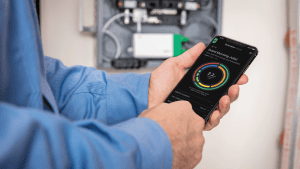Power demand in semiconductor manufacturing
Semiconductor fabs use up to 100 megawatt-hours of power each and every hour
Semiconductor manufacturing facilities require a massive amount of energy to support their facilities and manufacturing processes. Large fabs can use as much as 100 megawatt-hours of power each hour – more than many oil refineries and automotive plants. Energy use will continue to increase with higher production and more complex processes. For example, the latest extreme ultraviolet lithography technology requires up to 10 times more energy than before.
Why reliable power is essential
The journey from raw material to finished chip typically takes 85 days and encompasses up to 300 separate operations. The equipment used to complete these steps include ion implanters, photolithographic steppers, deposition systems, oxidation furnaces, etchers, and more.
Each of these sophisticated semiconductor fabrication processes demands high-quality, reliable power. Any electricity supply issues, such as a power outage or voltage sag, can disrupt operations and lead to wasted batches of semiconductors. These outages or voltage sags can be caused by different factors. They can be related to infrastructure quality, such as India’s unstable power supply. They can also be caused by external events like weather disasters, such as the power outage caused by cold weather that shut down U.S. semiconductor plants.
Financial and operational impact of power disturbances
A short power outage can threaten months’ worth of chip production because the outage affects each part of the manufacturing process. Outages are also expensive, typically costing around a few million dollars but up to tens of millions in some instances. Reducing this unplanned downtime through better power management can avoid unforeseen manufacturing costs.
Semiconductor fabs can rely on their electricity supply with future-ready electrical distribution technologies
There is a thin line between plants’ success and failure in this “winner takes all” industry. Having reliable, resilient power is one of the differentiators because of the substantial effects power disturbances have on fabs’ costs, process efficiency, and productivity.

Successful fabs ensure reliable power by having a well-designed and future-ready electrical distribution infrastructure. These digitally transformed facilities can, for example, confidently deploy the latest microprocessor controlled, sensor equipped tools, which are even more sensitive to electricity quality than previous generations. When a fab can trust in high quality, high availability power from its electrical distribution network, it can also more quickly adapt to changing needs.
Such as an uninterruptable power supplies (UPS), power metering, and digital solutions to prevent system shutdowns
There are a number of ways to reduce downtime risks. One of the most impactful is to use an uninterruptable power supply (UPS) to reduce the effect of power problems. UPSs ensure the continuous operation of process automation and control systems and help ensure power availability to critical infrastructure. Incoming voltage disturbances like peaks, surges, drops, and harmonics are also conditioned by the UPS. This high-quality power to sensitive tools and processes helps them run most efficiently, prevents equipment failure or malfunctioning during transient power glitches or temporary power loss, and protects expensive equipment from premature wear.
How does this work? A UPS senses when the mains power is fluctuating or cut. Its internal circuitry is fast enough to assume the power load so that downstream devices are not affected. The UPS then uses the power stored in its batteries to act as a bridge until power to the mains is restored or until gas or diesel generators can be fired up to temporarily support the load.
Fabs can also increase operational efficiency, continuity, reliability, and safety for power and control systems using power monitoring solutions and power metering. Power monitoring software provides insight into electrical system health and energy efficiency so fabs can make informed decisions that improve performance. The facility’s metering architecture allows for optimized readings in different parts of the facility. For example, power metering and monitoring solutions can track consumption by energy equivalent values (kWh) related to semiconductor manufacturing equipment against targets and verify energy efficiency improvements according to SEMI (Semiconductor Equipment and Materials International) S23.
For example, one semicon fab used technology solutions to prevent downtime and identify system abnormalities
A large semiconductor chip manufacturer and foundry that produces around 500K wafers per year uses these types of solutions to meet some of its biggest power availability challenges.
The manufacturer needed to maximize electrical system availability and reliability, ensure 24/7 operation of more than 1,500 OEM process tools, and mitigate grid excursion. It successfully secured power with UPSs, in combination with power monitoring software and meters that provides real-time information. These allow the fab to better manage its energy cost, quality, and reliability across the facility.
The result is a safer, more reliable, and more efficient electrical system. The fab now has access to detailed analysis reporting used to improve the plant’s power quality. They are notified of system abnormalities by SMS. It also complies with power quality compliance standards, such as EN 50160.
Learn more
Download our semiconductor brochure to learn more about secure power for sensitive semiconductor processes.



